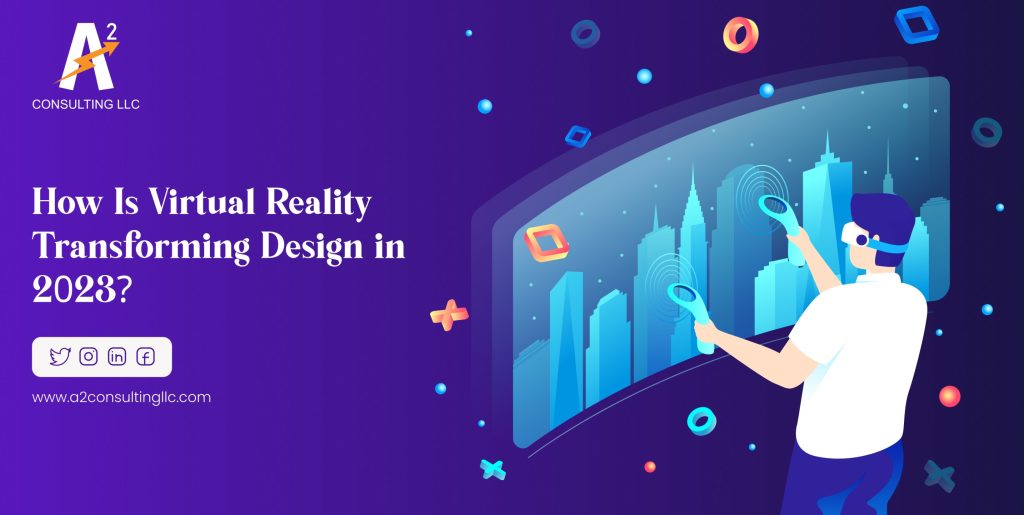Virtual Reality Transforming Design– Virtual reality (VR) technology has the potential to revolutionize the way design is created, experienced, and communicated.
In architecture, for example, VR allows designers to create highly detailed and immersive 3D models of buildings that can be explored by clients and stakeholders in a way that is much more engaging and interactive than traditional 2D plans or renderings.
VR can also be used to simulate different lighting conditions, weather, and even sound, making it a valuable tool for architectural acoustics, lighting design, and environmental design.
- Product Design: In product design, VR can be used to create virtual prototypes that can be tested and refined before physical prototypes are built. This can save a significant amount of time and money in the product development process.
- Interior Design: In interior design, VR can be used to create highly detailed 3D models of rooms and spaces that can be explored in a way that is much more engaging and interactive than traditional 2D plans or renderings.
- Automotive Design: In automotive design, VR allows designers to create and test highly detailed 3D models of cars, including interiors and exteriors, that can be explored in a way that is much more engaging and interactive than traditional 2D plans or renderings.
- Fashion Design: VR can also be used in fashion design to create virtual fashion shows and runway events, allowing designers to showcase their collections in a highly engaging and interactive way to potential buyers and the media.
Virtual reality is transforming design by making it more immersive, interactive, and engaging, and by allowing designers to create, test, and communicate their designs in ways that were not previously possible.
Design Practices in Virtual Reality
Virtual Reality Transforming Design
In virtual reality (VR), designers can create highly detailed and immersive 3D models of their designs, allowing them to explore and test their ideas in a way that is much more engaging and interactive than traditional 2D plans or renderings.
One common practice in VR design is “spatial prototyping,” in which designers create virtual prototypes of their designs and test them in a virtual environment. This allows designers to explore their designs from different perspectives, test different variations, and make changes in real time.
It can save a lot of time and money in the design process, as well as allow for more efficient communication and collaboration between designers and stakeholders. Another common practice in VR design is “co-design,” in which designers and stakeholders collaborate in a virtual environment, allowing them to explore and test designs together in real time.
This can lead to more informed and effective design decisions, as well as a more efficient design process.
Designers can create highly detailed and immersive 3D models, test designs in virtual environments, and collaborate with stakeholders in real time, all of which can lead to more efficient, effective, and engaging designs.
What new are we having in 2023 in Virtual reality designing?
Virtual reality technology is constantly evolving, with new advancements being made in areas such as haptic feedback, motion tracking, and facial recognition. These advancements are making VR experiences more immersive and realistic, allowing for more natural and intuitive interaction.
Some of the trends in VR design in 2023 will include:
- Increased use of VR in remote collaboration and remote work, allowing team members to work together in a virtual environment regardless of their physical location.
- More realistic and immersive VR experiences, thanks to advancements in haptic feedback and motion tracking.
- Greater use of VR in education and training, with VR simulations being used to teach everything from surgical procedures to industrial maintenance.
- Development of new VR applications for therapy, such as exposure therapy for phobias and post-traumatic stress disorder.
- Greater use of VR in architecture, construction, and real estate, with virtual walkthroughs of buildings and properties becoming more common.
- More use of VR in fashion and retail, such as virtual try-on and virtual showrooms.
- Greater use of VR in the entertainment industry, with virtual reality experiences becoming more common in theme parks, movies, and video games.
It is likely that these trends will continue to evolve and expand in the coming years, and new advancements in VR technology will open up even more possibilities for designers.
A2 consulting helps organizations incorporate VR design in a variety of ways, by providing VR software and hardware, VR design and development services, VR training and support, VR consulting, VR content creation, and VR analytics and metrics tools.
By working with these A2 consulting you can create effectively and engaging VR designs and experiences that help can help you achieve your goals. For more information visit www.a2consultingllc.com.

